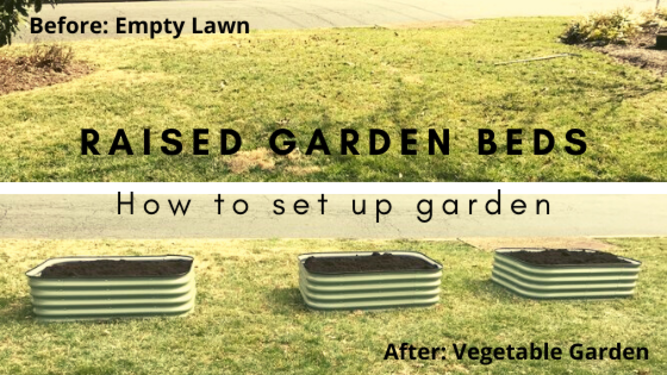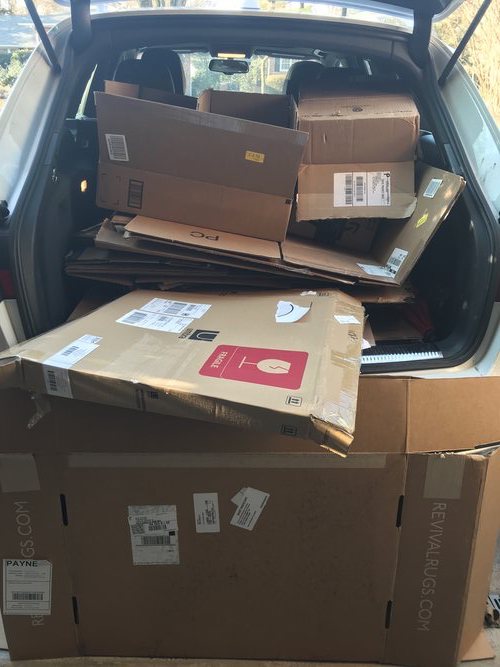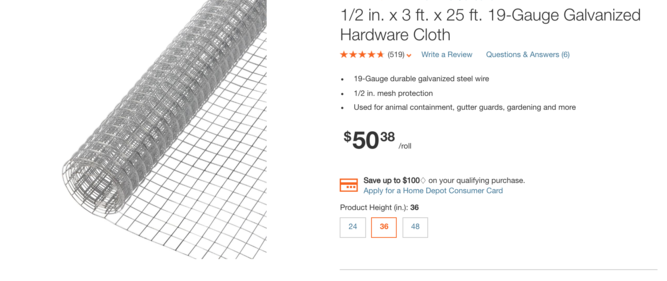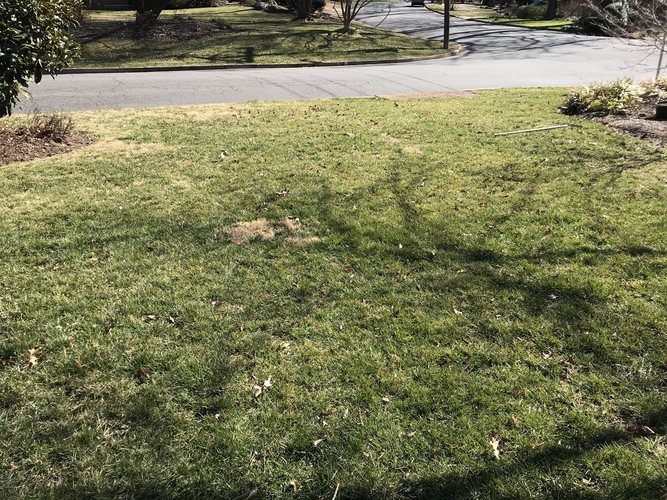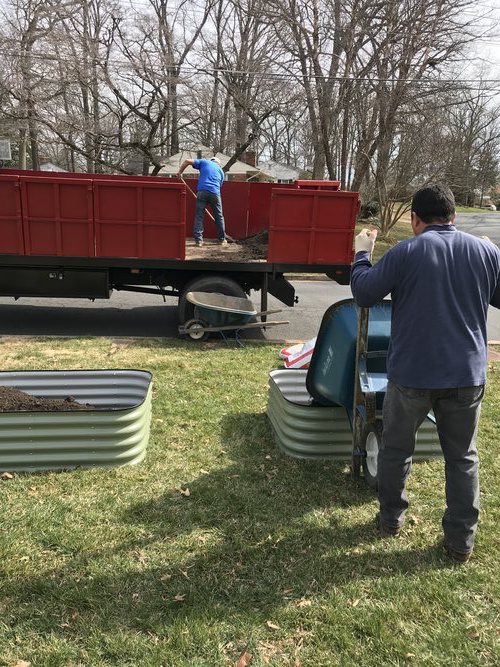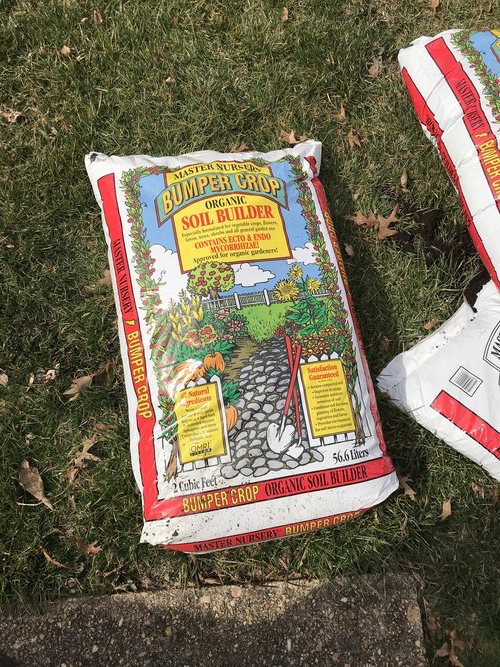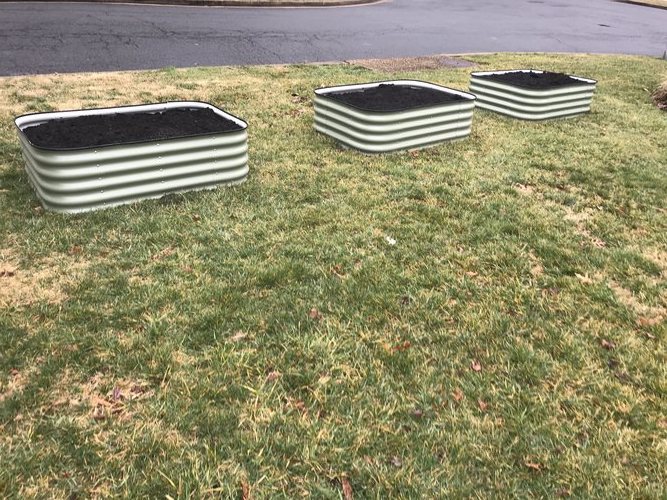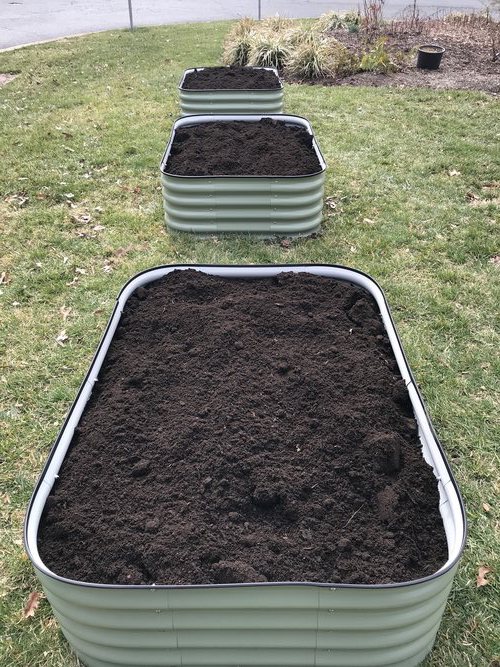By the way… any links on this page that lead to products are affiliate links and I get paid a commission if you purchase. Thanks in advance for your support.
You’ve come to the right place if you want to learn how to set up your garden with raised beds.
Pro-tip: Find a nice weekend to build outside. Breathe in the cool air and let your journey with outdoor vegetable gardens begin.
Being outside, if you find yourself needing to wrangle a couple of toddlers, you can set them up with bubbles. If you’re lucky, they won’t dump all the bubbles in each other’s hair! If you’re not so lucky (as was the case for us), you’ll need to take a break from building to wash all those suds out before their naps.
Back to the raised beds. There are a lot of different types of raised beds, which we go into more detail on here.
For this article, we’ll focus on our raised beds of choice called Birdies. These sturdy bad boys are made of cold-rolled galvanized steel with a metal coating composed of aluminum and zinc.
They come in a few colors and we chose the mint green because it’s such a pretty color.
Table of Contents
How To Set Up Garden With Birdies Raised Beds
It took us 45 minutes to build the first bed. This included a couple mistakes where we had to undo some pieces and screw them back together.
With the second build, we had two people. By this round, it only took 20 minutes.
These were so simple to install even with toddlers running around. You’ll see in the video below we’re lifting our heads from time to time. This was not to look at the camera.
We were chatting with our daughter and her friend who were playing in the yard as we were building. Get your kids involved.
We tried to get them to sort the screws and nuts, but that didn’t go so well. Stopped that before we lost any pieces.
Read my full review of the Birdies Raised Garden Beds.
Build The Beds
The Birdies beds comes with 6 flat panels and 4 rounded panels. You can configure the beds one of six ways to fit your garden space.
We chose the configuration that is 51″ x 35.4″.
Here are the tools we used to make building these beds faster.
- 8mm box-end wrench (closed)
- Cordless drill with Phillips head
- Scissors
- Two sets of hands
Step 1: Lay Out Materials
Lay out all the panels and remove plastic wrapping. There’s a thin plastic piece on the ends too, so don’t miss that.
We used two small bowls to separate out the screws and nuts. Not necessary but nice to stay organized.
Step 2: Assemble Flat Panels Together
Begin assembling the flat panels first. Screw the nuts into place with your hands five times down each panel. Set finished panels aside.
Step 3: Assemble Rounded Panels
Screw the remaining flat panels together with the rounded panels. Make sure the rounded panels go on the OUTSIDE.
We didn’t read the instructions carefully at first and started screwing panels together. Too excited. We had some flat panels on the inside, and others were attached on the outside of the rounded panels.
Make sure the rounded panels are on the OUTSIDE when screwing the rounded panels to the flat panels. Something about distribution of weight.
Now, I have warned you.
Step 4: Tighten Screws
This is where it gets really fun. Using an 8mm box-end wrench (closed) to hold the nut, we took a cordless drill with a Phillips head bit to tighten the screws.
Work all the way around until you’ve tightened all screws. This is a very important step!
We used a low torque setting on the drill to avoid over-tightening.
If you’ve never used a drill before, this is the time to learn. Speaking for myself (my husband uses the drill all the time), I felt powerful, fast, and efficient. I now understand why people love power tools!
Putting together Christmas Wish List now.
I told my husband to stop tightening the screws by hand, and let me continue on with the drill to finish the beds. Such fun!
In total we built three of these beds. We bought four originally, but decided to scale back.
Step 5: Add Safety Rubber Channel
Birdies provides a safety rubber channel in the box that protects the edge. This clips on permanently and is UV stable.
It was pretty easy getting the strip on top of the edges. The only tough part was where one panel met another. We’d have to squeeze the panels together with one hand. Then, carefully take the strip and put it over both panels at the same time.
Once you’ve wrapped the beds, take a pair of scissors or wire cutters and snip the excess rubber.
That’s it!
Raised beds completed in 20 minutes or less for each.
Our daughter managed to run and jump inside the empty bed and pretend it was a boat. Dual purpose product.
Set Up The Garden & Prepare The Ground For The Beds
There are a lot of opinions out there for preparing your ground for raised beds (and for any gardening topic, really).
Some people say to pull the grass up and others will say to simply place the beds on top of your grass and fill them with soil.
Trust your gut and do what you think works best for your space.
Cardboard As Your Base
We intended on laying down five layers of cardboard first to kill the grass and prevent weeds from coming up in the future. If you use cardboard, remove all labels and plastic tape first. The cardboard will decompose into the ground.
Don’t buy cardboard. If you live in a densely-populated area, people love to online shop. Drive around on trash pick-up day and pick up cardboard boxes.
We drove around and in 10 minutes, that’s right 10 minutes, and loaded our wagon up with a massive amount of cardboard. All for FREE.

Surplus of Free Cardboard on Street
Hardware Cloth For Digging Pests
Then we added a layer of hardware cloth. This metal layer prevents digging pests from coming up through our beds. These could potentially ruin crops.
Use aviation snips to cut the cloth. We used gardening gloves and the metal cut right through them. Use caution when cutting this stuff.
Then on top of the cardboard and hardware cloth, we placed the raised beds.
Changing It Up A Bit
We worried soil would drain out of the bottom of the raised beds.
The layers of cardboard were very uneven. With the beds sitting directly on top, this might be an issue. We knew it would take time for the cardboard to decompose.
We needed a solution that would prevent the soil from seeping out.
Later that evening we consulted the Birdies Facebook group. No, this is not an ad for Facebook Groups (ahem, Superbowl).
Everyone in the group said that the Birdies beds are 15″ high. This amount of soil will eventually kill the grass.
We picked from the options below which would allow the beds to sit directly on top of the grass.
Option 1: Remove all the cardboard, leaving the hardware cloth.
Option 2: Leave some cardboard inside the bed with the hardware cloth.
Considering the labor-intensive 10 minute task of collecting the cardboard, we chose Option 2. Didn’t want to waste our treasure.

Before: Empty Lawn 
After: Birdies Beds Assembled
How To Fill Raised Garden Beds With Soil
After you’ve placed the beds in your desired garden spot, what on earth do you fill them with next?
They say to fill them with soil. What soil? Soil from the ground? Probably not.
We have “Red Virginia clay” here in Northern Virginia. No one wants dry and hard soil for growing veggies, so what are we to do?
Step 1: Fill Your Beds With Topsoil
Quick Lesson On Soil
Topsoil is the top layer of ground. What’s found all the way at the bottom is the bedrock. “Bedrock is considered to be solid rock that formed in place and is the underlying foundation of an area. It will be the bottom-most layer, above which soil development takes place.”
Soil Components:
– 25% Air
– 25% Water
– 45% Mineral Particles (Calcium, Manganese, Phosphorous) from bedrock broken up by roots)
– 5% Organic Matter (alive organisms, roots, decaying matter)
Our biggest recommendation is to shop at a local nursery like Merrifield Garden Center. They can help you figure out how much topsoil and compost you will need for your beds.
Merrifield produces their own topsoil by recycling soils then adding 20% leaf gro (organic compost) to the mix. It’s an aged product and many gardeners have had success with it.
If you’re filling more than one raised bed, you might want to buy your soil in bulk — by the cubic yard. Use this Soil Calculator to figure out the total amount of soil you’ll need for each bed ahead of time. Of course this helps to calculate costs in advance too.
We used the soil calculator above and figured out we needed a little more than 1 cubic yard of topsoil. The man at Merrifield agreed that 1 cubic yard was enough. This was also the minimum amount needed to buy in bulk.
We recall him saying this would have been the equivalent to 30+ bags of topsoil. We don’t have a truck and weren’t planning on renting one, so delivery was our best option.
Delivery is also convenient because the delivery men will fill your beds for you if they’re close enough to the truck and street.

Got Some Help Filling the Beds
Step 2: Top Your Garden Beds With 2″ Of Compost
We wanted to top each raised bed with 2 inches of compost to add in nutrients not found in the topsoil.
Unfortunately, our home compost wouldn’t be enough for this project.
The nice man at Merrifield comes in handy again and recommended we buy three to four bags of Bumber Crop Organic Soil Builder.
This is OMRI listed. This ensures this product is suitable for organic food production.
He also told us Master Gardeners in the area use this. It’s full of organic ingredients like worm castings, lobster and crab shells, kelp meal, aged bark, to name a few.
We never heard of Bumper Crop before this. Had we gone in trying to find bags of “compost,” we’re not sure we would have left with the right products. Glad we asked.
Don’t be afraid to ask for help.
Remember the quick soil lesson we reviewed earlier?
We are only adding two inches or so of compost to beds.
Soil contains only 5% organic matter. This is why you cannot fill your beds with 100% of compost.
Step 3: Add Nutrients And Amendments
Lastly, sprinkle in pure organic worm-castings. This is pure worm poop digested from special worm feed. Just like it sounds, it looks like dark, tiny poop from worms. Find OMRI listed products again.
Plants that use up to 10% of worm castings in planting beds have proven benefits of less disease and less pests.
“Fruit and vegetable tests have resulted in yield improvements from 57% to over 200% as well as improvement in taste and appearance.”
Every manufacturer is different. Read the instructions on the bag and it’ll tell you how much to use for the size of your raised bed.
“Fruit and vegetable tests have resulted in yield improvements from 57% to over 200% as well as improvement in taste and appearance.”
– University of california agriculture & Natural resources
Not necessary, but you could add rock dust too. This is minerals of the earth right out of a volcano. Only use a tiny amount. Check the manufacturers instructions.
Step 4: Mixing The Ingredients
Use a rake and spread out all the materials. There is no need to mix everything into the soil.
Lastly, spray water above the bed and go back and forth over the bed, so everything is moist.
Pro-tip to save on water and time.
Add your soil, compost, and worm castings to your raised beds right before a rainfall. Let Mother Nature do her thing.

Asked for Rain and Got It 
Nice Dark Soil and Compost
Summary: Fill the Beds with Soil
- Step 1: Fill your beds with topsoil
- Step 2: Top your garden beds with 2″ of compost to add in nutrients. Find OMRI listed compost or products that say “Amend” organic plus (ingredients will say compost)
- Step 3: Add nutrients and amendments (in addition to compost) like pure worm castings.
Animal-Proofing Your Raised Garden Beds
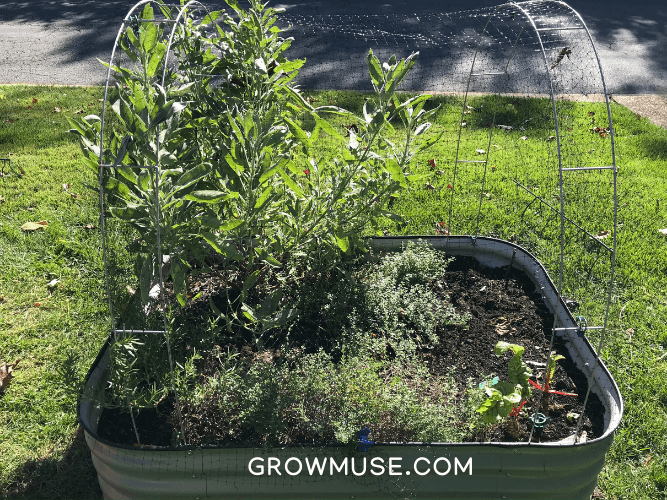
You’ll also want to add super high garden hoops to your garden. These hoops will hold up any netting or garden fabric you use to protect your crops from birds, squirrels, deer, and other animals that might want a bite of your plants.
If you’re using the Birdies raised bed, hoops are very easy to install without equipment. Simply push the hoops on each end into the soil deep enough so they don’t move.
You can then attach the fabric or netting with clamps.
Final Thoughts
This was a fun project to put together. As we positioned the Birdies beds out front, folks in the neighborhood stopped and chatted with us.
They’d ask what we were building. These beds don’t look very traditional.
We’d tell them raised beds for vegetables and herbs. We would then hear stories of their own gardens or neighbors’ gardens.
We overheard one woman say to her friend, “It’s so nice to see people building gardens here.” The fact she even said that means we all need to attempt to build our own gardens, so it’s more common in our communities.
Compare that to another neighbor who had come from the Pacific Northwest. She said every house has a front-yard garden. It’s normal to see people growing all sorts of things out front and neighbors sharing their harvest with each other.
The DC Metro area has a lot of families with both parents working full-time. It’s difficult to manage work, the household, and a kitchen garden. We get it. We’ve been there.
Is there a way to make vegetable gardening easier for beginners? Do you have plans to set up a garden this season? How much time do you plan to spend caring for it each week?
Comment below!
By the way… any links on this page that lead to products are affiliate links and I get paid a commission if you purchase. Thanks in advance for your support.

